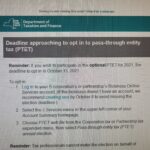Weekly Update – October 14th 2021
Global supply chain delays have become so bad that the biggest U.S. retailers are chartering their own cargo ships to stock shelves this holiday season. Walmart, Home Depot, Costco, and Target are among companies that are paying the additional expense to mitigate holiday disruptions. While the smaller ships these companies will use are far more expensive than the larger ones, they have the advantage of the ability to dock at smaller, less congested ports. This approach also gives these retailers added control over shipping schedules. Home Depot will use these smaller ships for only a small percentage of their goods, but will be using them for in-demand items such as holiday décor, heaters, power tools and plumbing supplies.
We are renovating one of our bathrooms and ordered the tiles over 2 months ago with a delivery promise date of October 10th (they have still not arrived). I guess my unfinished bathroom is a consequence of the consumer goods shipping bottleneck too.

Just last week I was talking about tax season 2021 winding down, of course we in the accounting profession have labeled the 2020-2021 the never ending tax season in jest. You will see in “TAX MATTERS”, below that the season has been extended yet again to January 3rd 2022. I changed the note for October 15th in our office calendar to: “INDIVIDUAL TAX RETURNS NOT DUE TODAY 🙁 “.
Yesterday morning I knew that it was time for another indoor/outdoor workout, starting on the beach and ending up with thirty minute on line spin class. The light was great, so I picked the 2 best to share with you:


Amazing that these were taken minutes apart, it’s all in the perspective.
THE AMERICAN RECOVERY PLAN ACT (ARPA)
Monthly Child Tax Credit Payments
The expansion of the Child Tax Credit from $2,000 per eligible child to as much as $3,600 and the option to receive a portion of those payments in advance has led to many questions. Kiplinger has answered many of those questions in this FAQ article. For example, what does it mean that this credit is fully refundable? This means that families who are eligible will receive the entire amount that they are eligible for, regardless of their income or tax liability.
As a reminder, if you want to opt out of future payments, you must opt out by the deadline for the next month’s payment. Check out the IRS FAQs where you’ll find everything you need to know about opting out in Section J.
TAX MATTERS
The IRS is Continuing to Experience Backlogs with Processing Returns and Notice Replies
While the IRS says it’s on track to process the pandemic-related backlog of 2020 tax returns by year-end, millions of taxpayers are still waiting for refunds. Many have been receiving confusing notices about changes to their refunds or are still waiting for refunds from prior year returns. It may take 90 to 120 days to process tax returns. The Where’s My Refund tool can shed some light but may only show that your return has been received. Calling the IRS may not help much: if you do manage to get through, the phone reps may not have any additional information. As with any correspondence from the IRS or state tax authorities, if you receive a letter notifying you of a 60-day-appeal period for contesting the IRS calculations for stimulus payments, don’t delay your response, and make sure your tax advisor promptly receives a copy.
Stimulus #1 & #2 Reconciliation and Reporting on Your Tax Returns
We have heard that many notices relate to inaccurate reporting of the stimulus money received in 2020 and through January 2021, representing the first 2 stimulus payments. When your reporting and the IRS’ records don’t matchup it’s up to you to prove them wrong, a time consuming and frustrating proposition. Where we saw what looked like inconsistencies with our expectations for stimulus funds, we contacted the IRS for their records and then asked our clients to research further. In most cases we were able to reconcile and then when appropriate request the missing funds as we prepared and filed the 2020 tax returns.
Tax Deadlines Extended for Many and For Many Tax Returns
Is October 15th really the end of tax season 2021? Not, not for us as of Tuesday evening when NYS issued N-21-5 announcing the extension of certain October 15th deadlines
Residents of New York and New Jersey impacted by Hurricane Ida now have additional time to file:
- January 3, 2022 to file Federal tax returns, but there is no extension past May 15th for any taxes due with the return.
- January 3, 2022 to file New Jersey business and individual tax returns and make tax payments.
- December 14, 2021 to file New York business tax returns and make tax payments.
- January 3, 2020 to file New York individual tax returns.
While NJ followed the IRS announcement almost immediately, the NYS announcement came in the final hours of the September 15th “perfect storm” deadline for extended corporation tax filings and the personal and corporation 2021 estimate #3, again this does NOT include the personal tax deadline of October 15th (glad they didn’t wait any longer). This extension applies to any tax returns or tax payments that normally would be due between September 1, 2021 and December 31, 2021. Residents of Louisiana also have an extension to file tax returns and pay taxes.
FINCEN just released guidance for an extended due date for 2020 FBAR filing as well.
The NYS Pass Through Entity Tax Workaround (PTE)
The NYS 2021-2022 fiscal year budget included a potentially favorable new law that can be elected annually beginning with 2021. The Pass-through Entity Tax (PTE tax) which many businesses with operations or investors in New York may want to take advantage of this year must be elected by a partner or shareholder by October 15th. For maximum effect, the estimated tax liability should be paid by December 31, 2021. This new tax is similar to tax laws passed in several other states recently and is a way for smaller businesses (and even some larger ones) in New York to work around the recent federal tax law changes that took away previously available tax deductions for state income taxes.
Under New York’s new PTE tax, any entity taxed as a partnership or New York S Corporation may elect into the New York PTE tax system. By doing so, the entity will be voluntarily electing to pay an entity-level income tax on at least a portion of its profits allocated to its individual investors (not corporations or other partnerships) at graduated rates starting at 6.85% on taxable income of $1 or more and increasing to up to 10.9% on incomes in excess of $25 Million. Pass-through entities electing-in to the tax for this year must do so by October 15. The election must be made by March 15 for each year after 2021.
Pass-through entities included under this law are:
- Partnerships;
- federal S corporations that have made the New York S corporation election; and
- Limited liability companies (LLCs) (not operating as a Schedule C -disregarded entity).
NYS sent out a mass email notice about this the afternoon of October 6th and really stirred the pot…

We have been considering the time and cost vs the actual benefit:
State sourced income for individual partner or shareholder:
- NY/NJ/CA sourced income of $50,000 yields a personal tax benefit of $1,200
- NY/NJ/CA sourced income of $75,000 yields a personal tax benefit of $1,800
- NY/NJ/CA sourced income of $100,000 yields a personal tax benefit of $2,400
- NY/NJ/CA sourced income of $200,000 yields a personal tax benefit of $4,800
So you can see we are not so thrilled about this “great benefit”.
NJ Pass-Through Business Alternative Income Tax Act (BAIT)
P.L.2019, c.320 enacted the Pass-Through Business Alternative Income Tax Act, effective for tax years beginning on or after January 1, 2020. For New Jersey purposes, income and losses of a pass-through entity are passed through to its owners. However, the law allows pass-through entities to elect to pay tax due on the individual owner’s share of distributive proceeds. The owner(s) may then claim a refundable tax credit for the amount of tax paid by the pass-through entity on their share of distributive proceeds. The purpose is to reduce federal taxable income thereby reducing an owner’s federal taxable income, while not affecting the NJ tax liability. The tax savings grown as the business net income increases.
Pass-through entities included under this law are:
- Partnerships;
- federal S corporations that have made the New Jersey S corporation election; and
- Limited liability companies (LLCs) (not operating as a Schedule C -disregarded entity)..
The entity must have at least one member who is liable for tax on their share of distributive proceeds pursuant to the New Jersey Gross Income Tax Act, N.J.S.A. 54A:1-1 et seq., in a taxable year.
Single member limited liability companies and sole proprietorships may not elect to pay the Pass-Through Business Alternative Income Tax.
We have been considering the time and cost vs the actual benefit:
State sourced income for individual partner or shareholder:
- NY/NJ/CA sourced income of $50,000 yields a personal tax benefit of $1,200
- NY/NJ/CA sourced income of $750,000 yields a personal tax benefit of $1,800
- NY/NJ/CA sourced income of $100,000 yields a personal tax benefit of $2,400
- NY/NJ/CA sourced income of $200,000 yields a personal tax benefit of $4,800
So you can see we are not so thrilled about this “great benefit”.
NEWS FOR OUR MEDICAL PRACTITIONERS
Phase 4 of HRSA Funds Application Portal is Now Open
We have watched webinars regarding this stimulus package; here is my summary of the program take-a-ways:
This program is available to providers who serve patients with any of several different types of public coverage including Medicare parts A, B, and C Medicaid fee for service or managed-care or children’s health insurance program. Dental service providers and behavioral health providers and assisted living facilities are also eligible. This program is funded with $17 billion.
Please note the following:
- You may need to reset your password If you have not accessed the portal within 90 days
- The application portal opened on September 29, the deadline to submit a completed application is October 26, 2021 at 11:59 p.m. EST.
- If you are approved to receive a phase 4 payment it can be used to cover lost revenues or eligible expenses dating back to the beginning of the pandemic.
- If you receive a payment, the payment can be used for lost revenues and increased expenses that no other sources (PPP #1 & 2, EIDL, HHS phase 1-2-3) were used for and dating back to January 1, 2020 through March 31, 2021.
- This program was established the provide more support to smaller providers.
- Call the support hot line (866-569-3522 extension 711) for information on the progress of your application or other issues
Please use the following links and telephone number:
https://www.hrsa.gov/provider-relief/future-payments application portal
https://cares.linkhealth.com/#/ application
https://www.hrsa.gov/rural-health/about-us/definition/index.html – if not in a rural area, but you service patients who live in a rural area
https://www.hrsa.gov/provider-relief resources- fact sheet, guides
Help Hot Line: 866-569-3522 dial 711
Provider Relief Fund (PRF) Report is Now Due
You may have received a request to submit your Provider Relief Fund (PRF) report for the period that ends on September 30, 2021. This report must be submitted on line and is due by November 1, 2021. If you have not filed yet, please check your email or mail for that notice.

We have assisted several of our clients with this application, let us know if you need our assistance and we can work with you as well. Please be advised that the process is a bit time consuming so be prepared to spend at least 1 1/2 hours on a video-chat with us as we supply the necessary information for your submission. We may also need to us fill in on certain employee information and patient care data.
THE GREAT REASSESSMENT
While unemployment overall fell to 4.8% for September, many women are staying out of the labor market. In September, 26,000 fewer women were employed than the previous month. COVID-19 outbreaks are sending schools into quarantine and remote learning and causing many workers to choose between work and staying home to care for family members. Since the pandemic began, labor-force participation rates have fallen for nearly all groups and are still below pre-pandemic rates. The lowest employment rate is for women ages 20 to 54, who may want to work, but have been deterred from seeking employment due to the pandemic.
REOPENING THE OFFICE AND REMOTE WORK OPTIONS
Remote work was available pre-Covid and it appears that an expanded remote work model is here to stay. This means that the new techniques we adopted and continue to implement are critical for building a successful corporate culture in a remote world. For example, social events may be best scheduled mid-week as a break from work rather than requiring team members, already worn out from work and online meetings, to log in late on Friday when they’re trying to shift into weekend mode. Investing in in-person events to bring everyone together a few times a year can also help to build engagement. We enjoyed our mid-summer get together for planning and to shoot our holiday card photo and update our headshots for our website. Myriam and Elizabeth stayed with me for a week and we were able to take early morning walks together on the beach.

Economic development for rural areas used to center on luring companies to locate in small towns and provide jobs for locals. With the rise of remote work, that model is shifting to cash incentives and other perks to lure remote workers those communities. Cities and locales, from Topeka, KS, to two counties in Alabama, are offering qualified remote workers incentives that range from cash to help buy a house to free coffee and martial arts classes. Applicants must pass a screening process that may include minimum salary levels from remote work and a commitment to stay in the area for at least one year.
ECONOMY
A third of working Americans are paying more for healthcare this year, according to a recent survey. That increase in health care costs is leading some to decrease retirement contributions and to increase their credit card debt. Some are delaying doctor visits or using up accumulated savings to pay for healthcare.
Job growth in September fell to its lowest pace for the year, with only 194,000 jobs added, compared to 366,000 in August. A continuing shortage of workers and the continuing surge of the highly contagious Delta variant of the coronavirus are keeping more people out of the workforce. While consumers have cash to spend and companies are eager to hire, many workers who left jobs during the pandemic have not yet returned to the labor force. The number of workers who cited the pandemic as the reason for not returning to work rose for the first time since January, a sign that the Delta variant is making people skittish about returning to work. Even increasing wages by as much as 30% for cooks has not helped keep restaurants fully staffed.
While the global economy is bouncing back, continuing impacts from the pandemic are keeping growth restrained, according to IMF chief Kristalina Georgieva: “Failure to close the massive gap in vaccination rates between advanced economies and poorer nations could hold back a global recovery, driving cumulative global GDP losses to $5.3 trillion over the next five years.” Nearly 46% of people around the world have received at least one dose of a vaccine for COVID-19, the vaccination rate in some countries is as low as 2.3%.
Rising energy prices may cause a new threat to the U.S. economy. Prices for crude oil and natural gas are both at seven-year highs while the national average for gasoline is a bit over $3 per gallon, almost a dollar higher than a year ago. Heating oil has also risen 68% this year. Higher prices for energy reduce consumer spending for other goods and services because people have little ability to cut their energy consumption in response to sudden increases.
Food prices have also risen in response to the pandemic. Meat, poultry, fish, and eggs have increased by 5.9% over last year, and by 15.7% since before the pandemic. The still-clogged supply chain bears some of the blame, as do weather problems and labor shortages. Hurricanes have disrupted sugar cane refineries, increasing the cost of sweeteners, as well as oil refineries and plastics manufacturing plants, which is leading to increases in the cost of packaging. Economists predict that food price increases will ease next year, and perhaps even decrease a bit. However, prices in restaurants are likely to remain high, due to a combination of increased food prices, higher wages and a shortage of workers.
GENERAL RESOURCES
- IRS resources for stimulus payments:
- Use the Get My Payment tool to check on EIP payment status
- Eligibility and general information about Economic Impact Payments
- A list of frequently asked questions for stimulus payments
- IRS information about the Advance Child Tax Credit Payments
- Portal to update information
- A list of frequently asked questions on the advance Child Tax Credit Payments
- The best source for up-to-date and accurate health information is the Center for Disease Control (CDC)
- Entrepreneur put together a listing of free tech resources for remote work
- The Consumer Financial Protection Bureau has warnings about COVID-related scams
- Fast Company has a listing of the best productivity apps for 2020
- PC Magazine explains how to carry your vaccination card on your phone
- How to create a strong password
We sincerely hope that you and your family are well and remain well. If you have any questions or concerns, don’t hesitate to reach out to us. We are all in this together!
Complementary Discovery Session
If you need help with your accounting, want to create a tax minimization plan, want to discuss your business growth plan or your finances, are concerned about retirement goals or need to be held accountable for your 90 day action plan, contact us for a complimentary discovery session or an appointment to just get started.
